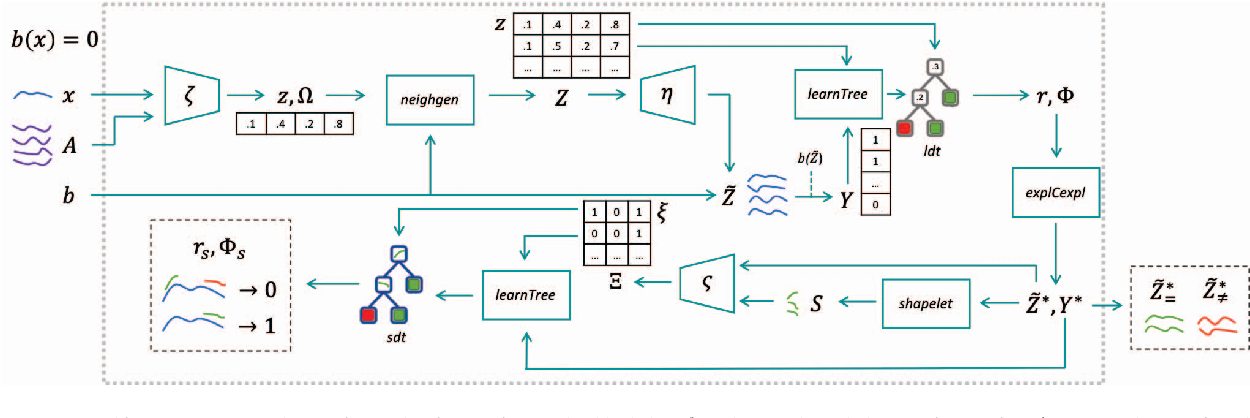Francesco Spinnato

Involved in the research line 1 ▪ 4
Role: Phd Student
Affiliation: Scuola Normale
6.
[SGM2023]Francesco Spinnato, Riccardo Guidotti, Anna Monreale, Mirco Nanni, Dino Pedreschi, Fosca Giannotti (2023) - ACM Transactions on Knowledge Discovery from Data
Abstract
The growing availability of time series data has increased the usage of classifiers for this data type. Unfortunately, state-of-the-art time series classifiers are black-box models and, therefore, not usable in critical domains such as healthcare or finance, where explainability can be a crucial requirement. This paper presents a framework to explain the predictions of any black-box classifier for univariate and multivariate time series. The provided explanation is composed of three parts. First, a saliency map highlighting the most important parts of the time series for the classification. Second, an instance-based explanation exemplifies the black-box’s decision by providing a set of prototypical and counterfactual time series. Third, a factual and counterfactual rule-based explanation, revealing the reasons for the classification through logical conditions based on subsequences that must, or must not, be contained in the time series. Experiments and benchmarks show that the proposed method provides faithful, meaningful, stable, and interpretable explanations.
7.
[PSG2023]Mattia Poggioli, Francesco Spinnato, Riccardo Guidotti (2023) - Proceedings of the 25th international conference on Discovery Science (DS), 2022, Montpellier. In Lecture Notes in Computer Science()
Abstract
Time Series Analysis (TSA) and Natural Language Processing (NLP) are two domains of research that have seen a surge of interest in recent years. NLP focuses mainly on enabling computers to manipulate and generate human language, whereas TSA identifies patterns or components in time-dependent data. Given their different purposes, there has been limited exploration of combining them. In this study, we present an approach to convert text into time series to exploit TSA for exploring text properties and to make NLP approaches interpretable for humans. We formalize our Text to Time Series framework as a feature extraction and aggregation process, proposing a set of different conversion alternatives for each step. We experiment with our approach on several textual datasets, showing the conversion approach’s performance and applying it to the field of interpretable time series classification.
12.
[LSG2023]Landi Cristiano,Spinnato Francesco, Guidotti Riccardo, Monreale Anna, Nanni Mirco (2023) - International Symposium on Intelligent Data Analysis. In Proceedings of the 2023 conference Advances in Intelligent Data Analysis XXI
Abstract
The large and diverse availability of mobility data enables the development of predictive models capable of recognizing various types of movements. Through a variety of GPS devices, any moving entity, animal, person, or vehicle can generate spatio-temporal trajectories. This data is used to infer migration patterns, manage traffic in large cities, and monitor the spread and impact of diseases, all critical situations that necessitate a thorough understanding of the underlying problem. Researchers, businesses, and governments use mobility data to make decisions that affect people’s lives in many ways, employing accurate but opaque deep learning models that are difficult to interpret from a human standpoint. To address these limitations, we propose Geolet, a human-interpretable machine-learning model for trajectory classification. We use discriminative sub-trajectories extracted from mobility data to turn trajectories into a simplified representation that can be used as input by any machine learning classifier. We test our approach against state-of-the-art competitors on real-world datasets. Geolet outperforms black-box models in terms of accuracy while being orders of magnitude faster than its interpretable competitors.
13.
[LCM2023]Liguori Angelica, Caroprese Luciano, Minici Marco, Veloso Bruno, Spinnato Francesco, Nanni Mirco, Manco Giuseppe, Gama Joao (2023) - Arxive preprint
Abstract
In real-world scenario, many phenomena produce a collection of events that occur in continuous time. Point Processes provide a natural mathematical framework for modeling these sequences of events. In this survey, we investigate probabilistic models for modeling event sequences through temporal processes. We revise the notion of event modeling and provide the mathematical foundations that characterize the literature on the topic. We define an ontology to categorize the existing approaches in terms of three families: simple, marked, and spatio-temporal point processes. For each family, we systematically review the existing approaches based based on deep learning. Finally, we analyze the scenarios where the proposed techniques can be used for addressing prediction and modeling aspects.
19.
[SGN2022]Spinnato Francesco, Guidotti Riccardo, Nanni Mirco, Maccagnola Daniele, Paciello Giulia, Bencini Farina Antonio (2022) - International Conference on Discovery Science. In Discovery Science
Abstract
In Assicurazioni Generali, an automatic decision-making model is used to check real-time multivariate time series and alert if a car crash happened. In such a way, a Generali operator can call the customer to provide first assistance. The high sensitivity of the model used, combined with the fact that the model is not interpretable, might cause the operator to call customers even though a car crash did not happen but only due to a harsh deviation or the fact that the road is bumpy. Our goal is to tackle the problem of interpretability for car crash prediction and propose an eXplainable Artificial Intelligence (XAI) workflow that allows gaining insights regarding the logic behind the deep learning predictive model adopted by Generali. We reach our goal by building an interpretable alternative to the current obscure model that also reduces the training data usage and the prediction time.
23.
[TSS2022]Andreas Theissler, Francesco Spinnato, Udo Schlegel, Riccardo Guidotti (2022) - IEEE Access. In IEEE Access ( Volume: 10)
Abstract
Time series data is increasingly used in a wide range of fields, and it is often relied on in crucial applications and high-stakes decision-making. For instance, sensors generate time series data to recognize different types of anomalies through automatic decision-making systems. Typically, these systems are realized with machine learning models that achieve top-tier performance on time series classification tasks. Unfortunately, the logic behind their prediction is opaque and hard to understand from a human standpoint. Recently, we observed a consistent increase in the development of explanation methods for time series classification justifying the need to structure and review the field. In this work, we (a) present the first extensive literature review on Explainable AI (XAI) for time series classification, (b) categorize the research field through a taxonomy subdividing the methods into time points-based, subsequences-based and instance-based, and (c) identify open research directions regarding the type of explanations and the evaluation of explanations and interpretability.
56.
[GMS2020]
Guidotti Riccardo, Monreale Anna, Spinnato Francesco, Pedreschi Dino, Giannotti Fosca (2020) - 2020 IEEE Second International Conference on Cognitive Machine Intelligence (CogMI)
Abstract
We present a method to explain the decisions of black box models for time series classification. The explanation consists of factual and counterfactual shapelet-based rules revealing the reasons for the classification, and of a set of exemplars and counter-exemplars highlighting similarities and differences with the time series under analysis. The proposed method first generates exemplar and counter-exemplar time series in the latent feature space and learns a local latent decision tree classifier. Then, it selects and decodes those respecting the decision rules explaining the decision. Finally, it learns on them a shapelet-tree that reveals the parts of the time series that must, and must not, be contained for getting the returned outcome from the black box. A wide experimentation shows that the proposed method provides faithful, meaningful and interpretable explanations.